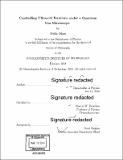Controlling ultracold fermions under a quantum gas microscope
Author(s)
Okan, Melih
DownloadFull printable version (22.48Mb)
Other Contributors
Massachusetts Institute of Technology. Department of Physics.
Advisor
Martin W. Zwierlein.
Terms of use
Metadata
Show full item recordAbstract
This thesis presents the experimental work on building a quantum gas microscope, employing fermionic 40K atoms in an optical lattice, and precision control of the atoms under the microscope. This system works as a natural simulator of the 2D Hubbard model, which describes materials with strongly correlated electrons. After preparing ultracold 40K atoms in an optical lattice and performing Raman sideband cooling, single lattice site resolution was obtained. Metallic, Mott insulating, and band insulating states were observed in situ and local moment was directly accessed as a local observable with the site-resolved imaging. Performing spin-selective imaging also gave access to spin, and spatial correlations of charge and spin was measured with respect to doping. In this measurements, antiferromagnetic correlations were observed in the spin sector. In the charge sector, we observed an anti-bunching behavior at low fillings, as a result of the Pauli exclusion principle and repulsive interactions. We also observed that doublon-hole bunching resulting from the superexchange excitations dominates and causes the charges to bunch. In order to increase the simulation capabilities, we updated the microscope with arbitrary optical potential imprinting ability. Using a digital micromirror device (DMD), a 2D box potential was created with the sharpness of a few lattice sites. A homogenous 2D Hubbard system is created at half-filling in this box potential. Using a magnetic gradient, different spin states were separated within a Mott insulator, being an ideal starting point for performing spin transport measurements. The lowest energy s-wave Feshbach resonance between 19/2, -7/2) and 19/2, -5/2) states of 40K was characterized with an increased precision and established as an interaction varying knob of our quantum simulator. Interaction energy spectrum around this resonance was measured. Confinement induced molecules on the attractive side and deeply bound molecules on the repulsive side are observed in an optical lattice.
Description
Thesis: Ph. D., Massachusetts Institute of Technology, Department of Physics, 2018. Cataloged from PDF version of thesis. Includes bibliographical references (pages 123-130).
Date issued
2018Department
Massachusetts Institute of Technology. Department of PhysicsPublisher
Massachusetts Institute of Technology
Keywords
Physics.